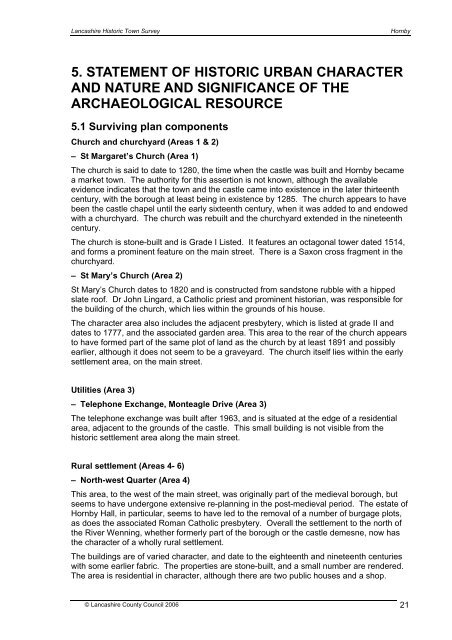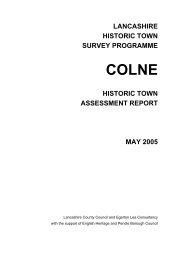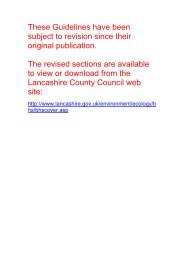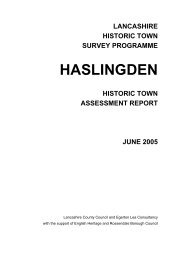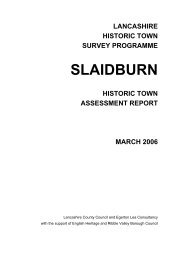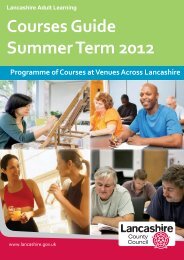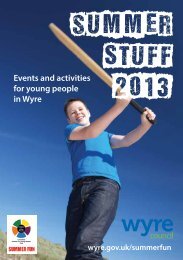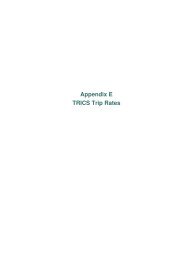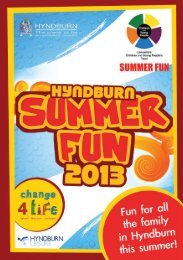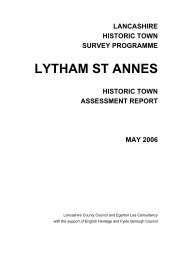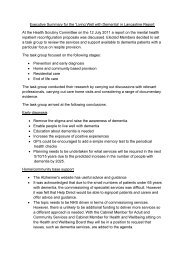HORNBY - Lancashire County Council
HORNBY - Lancashire County Council
HORNBY - Lancashire County Council
Create successful ePaper yourself
Turn your PDF publications into a flip-book with our unique Google optimized e-Paper software.
<strong>Lancashire</strong> Historic Town SurveyHornby5. STATEMENT OF HISTORIC URBAN CHARACTERAND NATURE AND SIGNIFICANCE OF THEARCHAEOLOGICAL RESOURCE5.1 Surviving plan componentsChurch and churchyard (Areas 1 & 2)– St Margaret’s Church (Area 1)The church is said to date to 1280, the time when the castle was built and Hornby becamea market town. The authority for this assertion is not known, although the availableevidence indicates that the town and the castle came into existence in the later thirteenthcentury, with the borough at least being in existence by 1285. The church appears to havebeen the castle chapel until the early sixteenth century, when it was added to and endowedwith a churchyard. The church was rebuilt and the churchyard extended in the nineteenthcentury.The church is stone-built and is Grade I Listed. It features an octagonal tower dated 1514,and forms a prominent feature on the main street. There is a Saxon cross fragment in thechurchyard.– St Mary’s Church (Area 2)St Mary’s Church dates to 1820 and is constructed from sandstone rubble with a hippedslate roof. Dr John Lingard, a Catholic priest and prominent historian, was responsible forthe building of the church, which lies within the grounds of his house.The character area also includes the adjacent presbytery, which is listed at grade II anddates to 1777, and the associated garden area. This area to the rear of the church appearsto have formed part of the same plot of land as the church by at least 1891 and possiblyearlier, although it does not seem to be a graveyard. The church itself lies within the earlysettlement area, on the main street.Utilities (Area 3)– Telephone Exchange, Monteagle Drive (Area 3)The telephone exchange was built after 1963, and is situated at the edge of a residentialarea, adjacent to the grounds of the castle. This small building is not visible from thehistoric settlement area along the main street.Rural settlement (Areas 4- 6)– North-west Quarter (Area 4)This area, to the west of the main street, was originally part of the medieval borough, butseems to have undergone extensive re-planning in the post-medieval period. The estate ofHornby Hall, in particular, seems to have led to the removal of a number of burgage plots,as does the associated Roman Catholic presbytery. Overall the settlement to the north ofthe River Wenning, whether formerly part of the borough or the castle demesne, now hasthe character of a wholly rural settlement.The buildings are of varied character, and date to the eighteenth and nineteenth centurieswith some earlier fabric. The properties are stone-built, and a small number are rendered.The area is residential in character, although there are two public houses and a shop.© <strong>Lancashire</strong> <strong>County</strong> <strong>Council</strong> 2006 21


